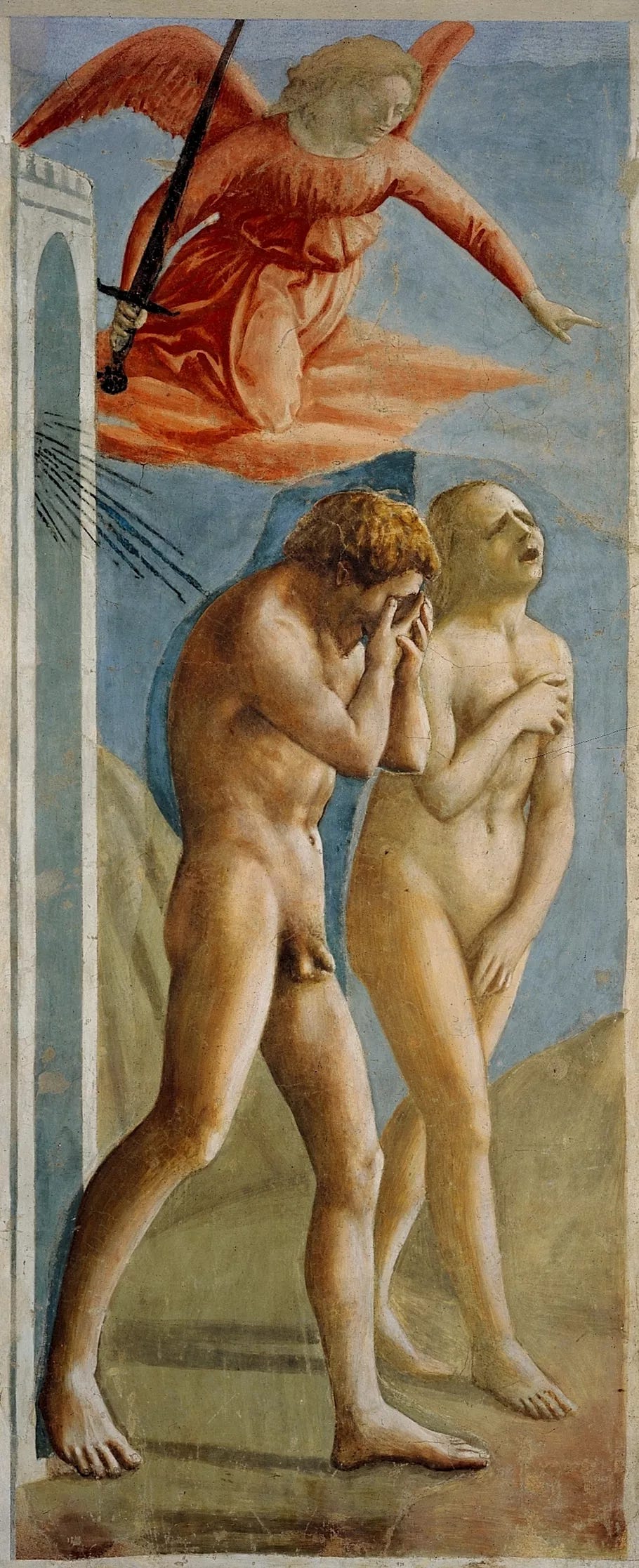This essay contains many spoilers for the Amazon Prime show Mr. And Mrs. Smith, and also a few for Madame Web, but nothing you wouldn’t have seen embedded in a Twitter meme.
Italian Renaissance artist Masaccio’s The Expulsion from the Garden of Eden is an ever-present existential mirror in Mr. and Mrs. Smith, an Amazon Prime miniseries adapted from the 2005 movie of the same name.
The at least 10-foot painting, or a copy of it likely, hangs in the office of Jane and John (Maya Erskine and Donald Glover)’s lush Manhattan apartment provided for them by some nameless high-powered employer who sends them on dangerous missions to bomb birthday parties, record ransom phone calls and assassinate agents from a rival company. The painting looms over them as they’re meeting for the first time, having debates about how to go about missions, considering betraying one another and eventually exchanging bullets.
It portrays Adam and Eve, naked and distraught, walking away from a Cherub angel who is doing the equivalent of newspaper swatting them out of her garden of Eden. The image derives from the Bible, a story in Genesis that tells of the first man and woman created by God. Eve convinces Adam to disobey God’s orders with her and eat an apple from the tree of wisdom and they’re punished with a kick in the ass and consciousness, essentially.
The image of this couple being driven out of a beautiful place that obviously never belonged to them is of course foreshadowing John and Jane’s journey. They are born anew in this agency, given new names and identities. Or more aptly, no name and no identity. You’d think a couple named John and Jane Smith would be a dead giveaway for spy activity, but mostly the basic names serve to show how interchangeable they are. Johns and Janes exist across the globe, many who haven’t been activated yet, but will fill in as soon as another couple is deemed no longer useful. They don’t need specific names because they’re disposable. A not so gentle reminder that this house is not their own.
I suppose Adam and Eve are the opposite of disposable. By nature, there is only one of them. God can give them clothes (derogative) and kick them out of his house but if he wants one of them dead it might be a bitch to make another. Still, they’re serving a master with high expectations. They have a job that is more important than who they are. And their inclinations to stray from that mission, to think for themselves, want for themselves, cost them dearly.
And most importantly, they’re not cogs in the machine by themselves. Adam & Eve, John & Jane, they’re paired together. It’s this idea of “pairing” that Mr. And Mrs. Smith toys with.
About three episodes into the series, I became skeptical of the story Glover and his co-creator Francesca Sloane were telling. The source material is an early 2000s action/romance romp better known for the real life-marriage it broke up. So in the shadow of Brangelina, the concept of ~chemistry~ was top of mind. Glover, in a press junket, said he chose to adapt such an iconic story because expectations would automatically be low. “I knew people would hate the idea of it because people loved the movie,” he said. “We knew we weren’t going to do it the same way. If we did it the same way people would of course get upset. We were allowed to do what we wanted because it’s not the same premise, but the feeling is still there. The core stuff you like about Mr. and Mrs. Smith is still there, which is relationships and spy stuff. Blowing stuff up.”
The blowing stuff up element was certainly there. The show went all in on the bells and whistles of “spy stuff” and brought in familiar faces to pull it off. The pair chase Michaela Coel through a train platform, follow Sharon Horgan down a ski slope, dodge bullets through the streets of Lake Como with Ron Perlman. It’s all good, clean fun. The relationship bit is where the series goes deeper, darker. It took a path the movie, in all its blockbuster glory, didn’t fully explore. But it took me a second to see the vision.

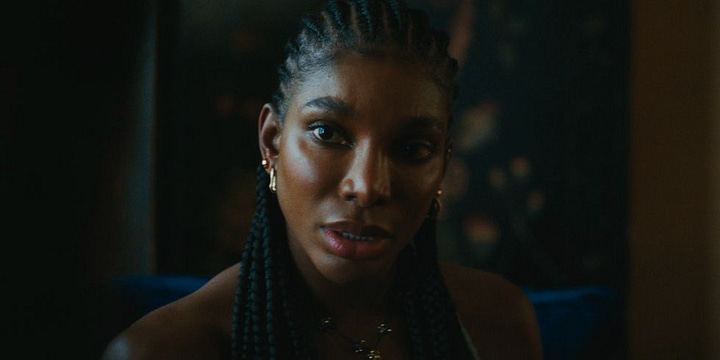
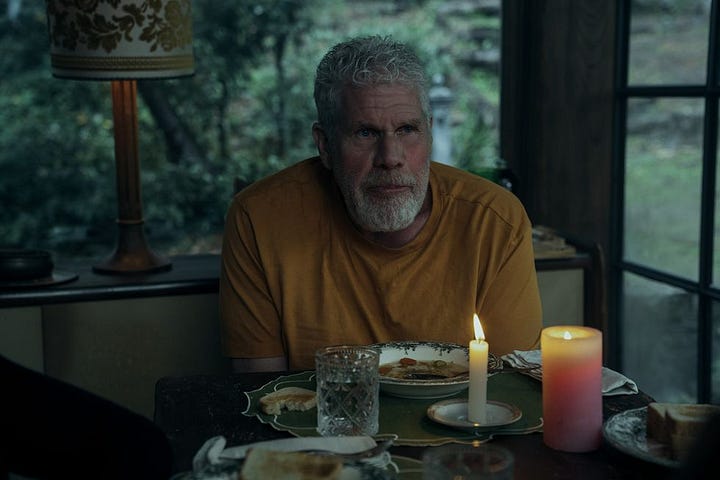
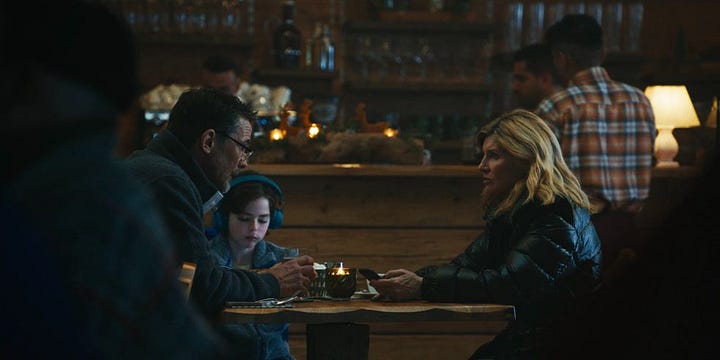
The chemistry between Glover and Erskine was palpable when they were awkward housemates, both electrified with the fear and adrenaline that comes with the danger of their jobs, but also the unknown of living with a stranger. Encountering a stranger can be kinetic, but being entered into a marriage with one is next level. Their personalities reveal themselves in spurts. Attraction and apprehension brew together in a way that’s fun to watch. Glover tucks Erskine’s hair behind her ear on a street corner, she rebuffs him and says their relationship should stay strictly professional, but it’s her own butterflies that are distorting the encounter. Glover is just helping her install an earpiece. It’s the tried and true coworkers-to-lovers tension you could cut with a knife.
And then they fuck.
It’s not unusual for two characters finally getting together to kill the tension that keeps watchers interested. It’s why shows put off inevitable pairings for seasons, sometimes full series runs (I don’t know why but Nancy and Andy Botwin in Weeds is the only example coming to mind…) But the chemistry hadn’t died between Erskine and Glover. Their dynamic just accelerated at a pace that felt false. You see them hooking up at the end of one episode, and by the next they are holding hands in the car, buying vacation homes, fighting over having kids.
Watching it felt uncomfortable in the same way watching a poorly constructed rom com does, or really any movie where, by the end of the film, the characters’ relationship to each other is miles apart from where they started without it feeling particularly earned. I watched the cinematic masterpiece Madame Web over the weekend. The Marvel/not really Marvel movie starring Dakota Johnson is an impressive collision of bad, with ADR that doesn’t match the visuals and a plot as arbitrary as the limes in Dakota Johnson’s Arch Digest apartment tour. But the piece of it that really made the ending high camp (read: boldly nonsensical) was the relationship between Johnson and her trio of teen girls (including Sydney Sweeney in a strawberry blonde wig that just seemed unnecessary?). The movie offers one sweet scene of Johnson teaching the girls CPR, and several of her reluctantly saving their lives. And then she goes to Brazil, takes some iowaska1 or something and comes back ready to die for these girls. “Yep, they’re mine,” she tells the ER doctor asking if the girls are blood relatives. Only a drunk Australian woman in a club bathroom can pull off that quick a jump from stranger to family.
For movies like Madame Web, this accelerated progression is a failure of effective storytelling. But in Mr. and Mrs. Smith, John and Jane seemed like they were play-acting their relationship not because the story was lapsing but because they were.
The more I watched, the more their immediate acceptance of the marriage made complete sense. They had a job and part of that job was to be married. If you’re developing a crush on someone when the papers are already signed, the apartment is already bought, mortgage paid, king-sized bed ready for you to share, of course you’ll fall into the rhythms of what you think a deep and long-term relationship should be, even if in reality you don’t even know your partner’s real name.
While watching I thought to myself, This is like the Stanford Prison Experiment but with marriage. They should make that a thing! Oh wait… that’s literally the premise of Love is Blind, 90 Day Fiancé and probably five other dating shows I just haven’t watched. Glover and Sloane smartly play to our obsession with watching two strangers get squished into a relationship together just long enough to implode, adding even higher stakes.
But the situation alone isn’t enough. The characters’ personalities make them vulnerable targets to be lulled into the dollhouse their “employer” built for them. On the surface, John and Jane are opposites in both their approach to their jobs and their emotions, which becomes the root of their failure in both matrimony and espionage. Jane is colder, more calculating and detail-oriented. She gets the job done first, worries about everything else later. John calls his mother everyday.
But they share a longing for partnership and connection. Jane might describe herself as sociopathic, but she’s actually the most susceptible to the grandeurs and the promises of love. Having no familial ties, she’s never had a solid, loving relationship in her life and she is starved for one. John, we learn from his mother2 in the final episode, is addicted to attachment and connection. He’s a loverboy who makes Drake look like a… what’s the opposite of a simp? A hater? Drake is also a hater! Anyway, John longs for the “traditional” staples of adulthood: wife, kids, yard, but life’s gotten in the way (poor bb was ejected from the Marines for asthma “but I knew it was mostly anxiety” 🥺). So when someone comes along and offers them the love they’ve been craving, of course John and Jane are all in on playing house.
But it becomes exhausting to perform being yourself for someone else. They can’t escape each other, and they learn what it really means to be in a relationship with someone, getting on each other’s nerves, fighting over their different expectations for work, family and living conditions. The rush of so easily sliding into a partnership they’ve both always wanted fades in a way that is especially devastating, knowing that they lived the fantasy and perhaps played it to its bleak conclusion.
A few months in their dollhouse of a marriage and they begin to look like the despondent Adam and Eve, ejected from an idealized world. In the final episode, the two stand in front of a different painting at The Whitney, Edward Hopper’s A Woman in the Sun, depicting a naked woman smoking a cigarette and looking out a bedroom window. John says, obviously projecting, “I think it’s up to the observer whether she’s alone or just lonely.” Jane snarls, “Fuck you.”
These sweet summer children! I felt so bad for them as they were running down the High Line trying to kill each other. They fell for a trap set by a shadow boss, described as an all-knowing God by another pair of John and Janes played by the delightful Parker Posey and Wagner Moira (who felt so menacingly familiar before I realized he played Pablo Escobar in Narcos).

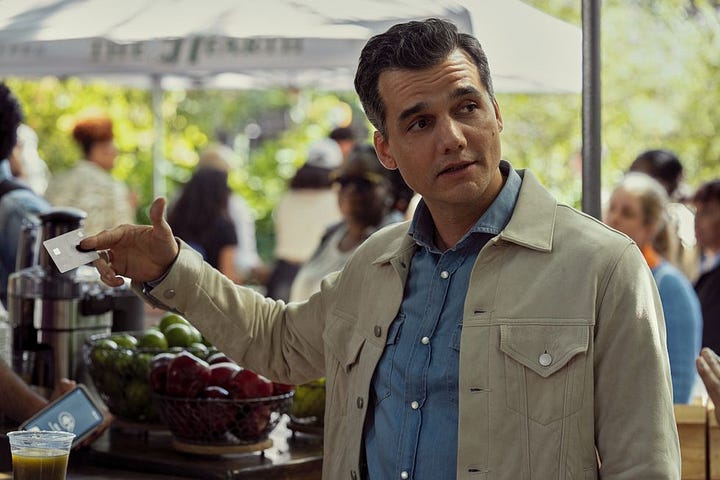
Their partnership wasn’t rooted in mutual connection and years of hard work. It was born out of convenience for an employer they’ll never even know. And the Masaccio painting in their study ties that experience not just to high-risk super spies, but more broadly, challenging the idea of “pairing” entirely. Adam and Eve, our original mother and father if the Abrahamic religions are to be believed, had a pretty similar deal, after all. It’s almost like heterosexuality as an institution is rooted in performance and production and not love and mutual life enhancement! But that’s none of my business!3
As anyone would do faced with a flailing marriage, The Smiths try therapy (with Sarah Paulson, who is really in her quirky cameo era with this and The Bear… Miss Jessica Lange, I hope you are taking notes). When that doesn’t work, they have emotional affairs. But they really can’t be honest with each other or themselves until the last episode, when they’re drugged with “truth serum.” In this breakthrough, they discover there are all these things they really do love about each other. When you throw away all the posturing, they’ve developed a real bond they just couldn’t lean into because their union allowed no room for it. When death feels like it’s near (John and Jane were informed that their positions had been “terminated”), John finally learns Jane’s real name, Alana. She had learned his, Michael, from his mother earlier that day. It would’ve been a good start. But whether it’s a lack of optimism that they’ll make it out of this particularly brutal corporate downsizing alive or if it’s because they know their love would be flimsy without this template of marriage and work, they submit to the roles they’ve been assigned.
“I like Jane,” John says as he’s bleeding out. “I like John,” Jane says, tears streaming down her face.
B Plot
Question: What is the most second hand embarrassment you’ve felt watching TV?
Mallika: There is obviously nothing more cringe than when someone starts singing. I know for a fact what Rachel’s answer will be, and it is the epitome of the cringey singing performance, but I will let her have it as it is a sacred moment to her. Instead I’ll go with when Betty did a striptease on Riverdale while singing “Mad World.” Her mom is there. Her boyfriend’s dad is there (clapping… but that’s for another day). Why is she taking her clothes off and why didn’t anyone say “girl, let’s sit this one out”? Runner up: Finn singing “You're Having My Baby” to Quinn in front of her parents made somehow worse by the fact that he is in fact not having her baby.
Rachel: Mallika knows me too well and this is not a cold take but watching Marnie Michaels take the mic and perform a dressed down version of Kanye West’s “Stronger” for the first time sent me into near cardiac arrest. I had to put my watch of Girls on pause and I didn’t gain the courage to pick it back up until YEARS later, and I’m better for it. I guess you could say Marnie did make me “stronger” in the face of secondhand embarrassment. I watched her perform Summer Lovin’ at Hannah’s birthday party while Ray was getting the shit beat out of him and hardly batted an eye. And that’s growth… not for Marnie though…
C Plot
Only Murders in the Building is turning into Law & Order and it has nothing to do with the murders — they’re just hiring every actor under the sun. Eva Longoria, Kumail Nanjiani, Eugene Levy… who’s next? We DARE them to make it Leighton Meester and Adam Brody for ONCE.
Sex & The City is coming to Netflix and it might make a new generation of women insufferable. Good luck, Gen Z! We hope you I couldn’t help but wonder… your little hearts out, but don’t get any grand ideas. A newspaper column shall not be paying your rent in the West Village.
Beef is reportedly eyeing Charles Melton, Cailee Spaeny, Jake Gyllenhaal and Anne Hathaway for season two which is HUGE if true. The two hottest Hollywood newcomers hitting the Oscar’s stage for their depictions of two famously groomed real-life individuals and Jake Gyllenhaal… who just nearly escaped the Swiftie death grip taking aim at his relationship with a 20 year old when he was 29 (which is mostly fair, although his crimes are less egregious than Elvis’). In seriousness, all these phenomenal actors on screen together would be a blast, but we must put a stop to constantly pairing Anne Hathaway with fussy 5’9 brunette men! Wasn’t she put through enough hosting the Oscar’s with James Franco that one time? And then she had to work with Jared Leto! We know she is friends with Jeremy Strong and who can blame her but leave the woman alone.
Played by Glover’s actual mother, something Erskine also did in Pen15.
It unfortunately really is my business…





